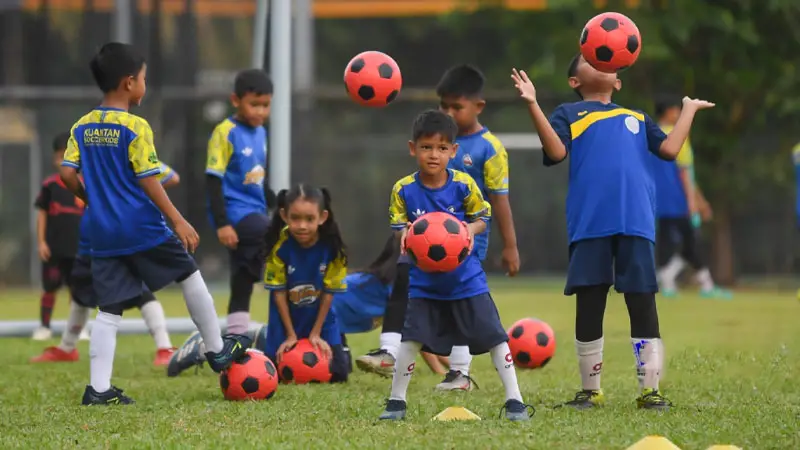Soccer, also known as football in many parts of the world, is a beloved sport that captivates players and fans alike with its fast-paced action and strategic gameplay.
For kids stepping onto the field, understanding the fundamental rules of the game is crucial to their development as young athletes. In this article, we’ll explore the top 10 basic rules that every child playing soccer should know to enjoy the game to its fullest.
From learning about the dimensions of the field to grasping the concept of offside, these rules lay the foundation for a fun and fair soccer experience.
Whether it’s knowing when a goal is scored or the importance of sportsmanship on and off the field, these guidelines will help young players navigate the game with confidence.
So, lace up your cleats, grab your ball, and let’s dive into the essential rules that shape the world’s most popular sport for kids.
10 Basic Rules for Kids in Soccer
To excel in soccer, kids need to grasp field dimensions, goal scoring rules, and the offside rule. They should also understand throw-in techniques, goalkeeper rules, corner kick procedures, and knowledge of fouls and misconduct.
Furthermore, fostering sportsmanship, honing basic dribbling skills, and heeding coaches for direction and teamwork are crucial for a rewarding soccer journey.
Rule 1: No Hand Touches
In soccer, one of the basic rules is that players are not allowed to touch the ball with their hands during play, except for the goalkeeper. When the goalkeeper is within their penalty area, they have the special privilege to use their hands to play the ball.
Exceptions for Goalkeepers
Goalkeepers are the only players on the soccer field who are permitted to use their hands to handle the ball but only within their designated penalty area. Once they step outside this area, they must abide by the same rule as other players and cannot touch the ball with their hands.
This exception highlights the unique role of goalkeepers in the game and the strategic advantage they bring to their team’s defense.
Rule 2: Kick-Off Procedures
Kick-off in soccer begins matches and restarts play after goals, with teams determined by a coin toss for direction choice.
Starting the Game
When the game begins or after a goal is scored, a kickoff is used to start or restart the play. During a kickoff, the team that wins the coin toss chooses which goal to attack and the other team kicks off.
All players must be on their respective half of the field, and the ball must move forward during the kick-off. The game officially starts when the ball is in play after the referee’s signal.
After a Goal Is Scored
After a goal is scored, the team that conceded the goal takes the kickoff. The team that scored must retreat to their own half, and the goalkeeper cannot touch the ball until it has been played by another player.
The kickoff marks the resumption of play after a goal and allows the conceding team to restart the game strategically.
Rule 3: Ball In and Out of Play
When it comes to soccer, understanding the boundaries of the field is crucial for young players. Here’s what they need to know:
Determining Boundaries
The boundaries of a soccer field are defined by the lines marking the edges. When the ball goes completely over any of these lines, it is considered out of play. Players should pay close attention to these boundaries to stay actively engaged in the game.
Consequences of the Ball Going Out
When the ball goes out of play, either over the touchlines or the goal line, specific actions are taken depending on the situation. For instance, if the ball crosses the touchlines, a throw-in is awarded to the opposing team to put the ball back into play.
Similarly, if the ball goes out across the goal line but not into the goal, a corner kick or a goal kick is granted accordingly, allowing for different tactical opportunities in the game.
Understanding these consequences helps kids grasp the flow of the game and their roles in different situations.
Rule 4: Scoring in Soccer
Scoring occurs when the entire ball crosses the goal line between the goalposts and beneath the crossbar.
How a Goal Is Scored
Scoring a goal in soccer is the ultimate objective for teams. It happens when the entire ball crosses the goal line between the goalposts and beneath the crossbar. This signifies a successful execution of teamwork and skillful play, bringing joy and reward to the scoring team.
Role of the Goalkeeper in Preventing Goals
The goalkeeper plays a crucial role in preventing goals. They are the last line of defense, tasked with blocking shots on goal and organizing the defense to minimize scoring opportunities for the opposing team.
A skilled goalkeeper can make strategic saves that can change the course of a match, showcasing the importance of their position in soccer.
Rule 5: Offside Rule Simplified
Understanding the offside rule in soccer is crucial. Players must not be nearer to the opponent’s goal than both the ball and the second last opponent.
Understanding the Offside Position
In soccer, the offside rule can be a bit confusing, but it’s crucial for young players to understand. A player is in an offside position if he or she is nearer to the opponent’s goal line than the ball and the second last opponent when the ball is played to them unless they are in their own half.
Being in an offside position isn’t an offense in itself; it only becomes an offense if the player becomes involved in active play by receiving the ball.
Impact on Game Play
Understanding and applying the offside rule can significantly impact game dynamics. By staying onside, players can create better scoring opportunities while maintaining fair play.
It encourages strategic positioning and teamwork, promoting a more organized and enjoyable soccer experience for everyone involved.
Learning to navigate the offside rule can enhance players’ overall understanding of the game and contribute to their development as skilled and disciplined athletes.
Rule 6: Throw-ins and Restarts
Throw-ins and restarts in soccer are critical for keeping the game flowing and fair. Here’s how these rules contribute to gameplay dynamics and strategy.
Correct Way to Execute a Throw-In
When it comes to throw-ins in soccer, players must execute them properly to ensure fairness and adherence to the rules.
The correct way to execute a throw-in is to stand with both feet on or behind the touchline, keep both hands on the ball, and throw the ball with both hands from behind and over the head.
Remember, the thrower must face the field and have both feet on the ground during the throw to maintain fairness and follow the regulations.
When and Where Throw-Ins Occur
Throw-ins occur when the ball fully crosses the touchline, either on the ground or in the air, and goes out of bounds.
They take place from the spot where the ball exited the field and must be performed by a player from the opposing team of the one who last touched the ball before it went out of play.
Players have a few seconds to complete the throw-in, and the location is crucial as it dictates the starting point of play after the ball goes out of bounds. Mastering the timing and placement of throw-ins can provide strategic advantages during a match.
Rule 7: Goal and Corner Kicks
In soccer, understanding the differences between goal kicks and corner kicks is crucial for young players to excel on the field.
Goal Kicks
- Definition: Goal kicks are awarded when the ball goes out of bounds past the goal line after being touched last by an attacking player.
- Placement: The ball is placed inside the six-yard box, which is the small rectangular area in front of the goal.
- Restart: The defending team takes the goal kick, positioning the ball anywhere inside the six-yard box. Players from both teams must remain outside the penalty area until the ball is in play.
- Objective: The goalkeeper usually takes the goal kick, aiming to kick the ball upfield to restart play and move it away from their own goal area.
Corner Kicks
- Definition: Corner kicks are awarded when the ball crosses the goal line after being last touched by a defending player.
- Placement: The ball is placed inside the corner arc nearest to where it went out of play.
- Restart: An attacking player takes the corner kick, typically from the corner flag nearest to where the ball went out of bounds.
- Objective: Corner kicks provide an excellent scoring opportunity for the attacking team. The goal is often to cross the ball into the opponent’s penalty area, where teammates can attempt to score with a header or volley.
Strategic Implications
- Goal Kicks: Allow the defending team to regroup and organize defensively. They can also be used to start counter-attacks if the goalkeeper’s kick reaches a teammate in an advanced position.
- Corner Kicks: Provide a strategic opportunity for the attacking team to create scoring chances. Players can use various tactics, such as short corners or direct shots on goal, depending on the situation.
Rule 8: Direct and Indirect Free Kicks
In soccer, understanding the difference between direct and indirect free kicks is crucial for players of all ages. These free kicks offer players the opportunity to capitalize on opposing team fouls or infractions to advance in the game.
Recognizing the Type of Free Kick
When a direct free kick is awarded, it means that the player can shoot directly towards the goal and attempt to score without needing another player to touch the ball first. On the other hand, an indirect free kick requires another player to touch the ball before a goal can be scored.
Understanding these distinctions helps players strategize and choose the best approach for each situation.
Setting Up for Free Kicks
Before taking a free kick, players must consider several factors to increase their chances of success.
Setting up for a free kick involves proper positioning of the ball, understanding the defensive wall formed by the opponents, and communicating effectively with teammates to capitalize on the opportunity.
It’s essential for players to stay focused and prepared to execute the kick with precision to outsmart the opposition.
Rule 9: Fouls and Penalties
In youth soccer, understanding common fouls is crucial for players to maintain fair gameplay. Some common fouls include tripping opponents, pushing, holding, and dangerous plays like high kicks.
Common Fouls in Youth Soccer
- Tripping: When a player intentionally or recklessly causes an opponent to trip or fall.
- Pushing: Using force to move an opponent out of the way.
- Holding: Grabbing or restraining an opponent to impede their movement.
- Dangerous play: Actions that endanger the safety of players such as high kicks.
Consequences and Disciplinary Actions
When a foul occurs, the referee may award a free kick, either direct or indirect, depending on the severity of the foul. In more serious cases, the referee may issue a yellow or red card.
- Yellow Card: A warning for misconduct that results in the player being cautioned.
- Red Card: Given for serious offenses, resulting in the player being ejected from the game.
Understanding the consequences of fouls and disciplinary actions helps young players learn about accountability and fair play in soccer.
Rule 10: The Game’s Duration and Breaks
Understanding the game’s duration and break times is essential for young players to manage their energy and strategize effectively throughout the match.
Standard Length of Matches
Knowing the standard length of soccer matches is crucial for young players, ensuring they pace themselves, strategize effectively, and stay engaged throughout the game.
- Youth Soccer: Youth soccer games typically consist of two halves, each lasting 25-30 minutes for the younger age groups and 30-40 minutes for older players.
- Competitive Matches: For more competitive matches or advanced age groups, game durations can extend up to 45-50 minutes per half.
- Stoppage Time: It’s common for referees to add stoppage time at the end of each half to compensate for time lost due to injuries, substitutions, or other interruptions.
- Strategizing Time: Understanding the game’s duration ensures that players pace themselves effectively and strategize within the allotted time.
Managing Time and Breaks
Managing time and breaks in soccer is essential for maintaining player energy, focus, and ensuring effective strategizing during and between game halves.
- Timekeeping: Referees are responsible for keeping track of time during soccer matches, starting the clock at kick-off and stopping it for injuries, substitutions, and other stoppages.
- Half-Time Break: There’s usually a half-time break of about 10-15 minutes between the two halves for players to rest, rehydrate, and receive any necessary instructions from coaches.
- Switching Sides: During half-time, teams switch sides of the field, allowing players to adjust their tactics based on wind conditions or other factors.
- Importance of Breaks: Breaks are vital for maintaining players’ energy levels and focus throughout the game, emphasizing the importance of utilizing this time effectively to regroup and plan for the next half.
Frequently Asked Questions
Why is it essential for children to learn fundamental soccer rules?
Understanding fundamental soccer rules enhances the game experience, promotes fair play, and helps in skill development for children.
What are some key soccer rules that children should learn?
Children should learn about field dimensions, goal scoring, offside, throw-ins, restarts, fouls, penalties, and game duration to have a comprehensive understanding of the game.
How can parents and coaches encourage fair play in children’s soccer games?
Parents and coaches can promote fair play by emphasizing sportsmanship, celebrating effort, encouraging communication, providing positive reinforcement, setting realistic expectations, promoting equal participation, teaching graceful winning and losing, creating a supportive environment, and leading by example.
What are some practical tips for teaching soccer to young children?
Focus on individual ball skills, keep players moving, avoid activities with lines, encourage peer demonstrations, create a positive learning environment, and demonstrate desired behaviors for effective teaching.
How does FIFA impact the rules and regulations of soccer?
FIFA, which stands for Fédération Internationale de Football Association, is the governing body for international soccer, responsible for setting and regulating the rules of the game worldwide.
Conclusion: Encouraging Fair Play and Enjoyment
Promote sportsmanship by teaching children to play with respect and celebrate effort over solely focusing on winning. Encourage communication, bonding activities, positive reinforcement, and equal participation to create a supportive environment.
By following these guidelines, coaches, parents, and guardians can set a positive example and cultivate a positive atmosphere for young soccer players to thrive.
Incorporating these fundamental principles will not only enhance players’ skills but also foster a sense of camaraderie and teamwork among the young athletes.
By emphasizing sportsmanship, communication, and equal participation, children will develop both as soccer players and individuals within a nurturing and encouraging setting.
This holistic approach will not only improve the players’ soccer abilities but also nurture their overall character development in a positive and supportive environment.
It is essential to prioritize values like sportsmanship, communication, and teamwork to help young athletes grow both on and off the field.








Brice Petersen